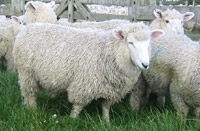Clover management key to lamb growth
Lambs able to graze a pasture which contains 70% clover and 30% ryegrass are able to increase the speed of their liveweight gain by 14%.
That is according to a study looking at pasture clover content and lamb liveweight gain. The joint WoolPro/Lincoln University study, which has just finished its second year, is headed by Dr Alastair Nicol.
Dr Derek Moot, of Lincoln University, who is also involved in the study, said this does not mean it is advocated that farmers try to achieve such high clover levels as for many reasons this would be impractical. Rather, the study is looking at what rates of lamb growth can be achieved at different clover levels with a view to optimising this in a practical way within a farming situation.
Dr Nicol pointed out benefits can be achieved even at a pasture clover level that averages 20% through the growing season, which he described as achievable and practical at the farm level. Presently, many farm pastures only reach a 5% clover content level, he said.
Dr Moot highlighted two important aspects of the study and how they can be incorporated into a farm situation.
Firstly, a farmer can look at increasing the clover content across the farm to bring it up to the 20% level, which will bring considerable benefits. Or, if he would like to achieve higher levels but still keep a practical approach to management, he can also look at including a specialist finishing pasture.
So, in situations where clover content is low, it is suggested a farmer addresses his new-grassing programme and adjust clover and grass sowing levels.
Dr Moot highlights two key points with resowing programmes – timing and sowing rates. For the study, which was in Canterbury, pasture was sown on 25 February, but Dr Moot said in Southland he would bring this date forward to late spring. The Canterbury sowing also involved drilling ryegrass and broadcasting clover whereas in Southland he suggests broadcasting both.
The most topical issue though is the rate of seed sowed, particularly ryegrass, which is probably a third of what most farmers would normally use.
In the study, 8kg of Nui low-endophyte ryegrass was sown per hectare with 2.5kg white clover and 5kg red clover (Remember that red clover seed is up to 5 times larger than white clover).
Dr Moot pointed out that red clover may only last three years but it provides high-quality feed during that time. Farmers may decide not to sow this at all but rather increase the amount of white clover. Huia white clover was used in the Canterbury study but Southland farmers may opt to use the locally bred Demand white clover.
He suggests a finishing pasture of Timothy with red and white clover. After two or three years when the red clover will have declined the Timothy will have established itself without the competition of ryegrass. It is at this time ryegrass can be direct drilled resulting in a high white clover, permanent ryegrass pasture with the added benefit of Timothy.
Phosphorus, sulphur, and potassium levels all tested adequate. The pH level was 5.5 and although Dr Moot said he would prefer this to have been at least 5.8, nothing was done to adjust the level. The status of trace elements also tested as adequate.
Dr Moot said if pastures like the two described above, or any white clover/ryegrass pasture, can be managed right he would struggle to offer anything better in Southland.
There is no magic bullet – it is all about good timing and good practices, he said.
The key in Southland is good set-stocking in spring where pastures should be maintained at 1000 to 1200 kg/DM to maximise clover growth into the summer. Higher spring pastures can lead to ryegrass stifling out clover. It is important that the light is allowed to hit the white clover stolons (runners) – the more light, the more clover, Dr Moot said.
He accepts that spring pasture management is not always the prime focus of farmers as they concentrate on getting live lambs on to the ground, but he said if farmers can spare time to manage pasture well at lambing, it will pay dividends in summer clover growth.
Note: In the recent MeatNZ paper distributed to farmers this week, entitled “Pastures for Profit,” a number of fertilisers and trace elements are listed as being important for clover production.
MeatNZ was contacted about the information as it lacked detail and specifics. A spokesman confirmed that, to the best of his knowledge, MeatNZ had not been involved with any fertiliser research on legumes and said he was “pretty sure” they would not be making any legume fertiliser recommendations in the future.
Instead, he suggested farmers adopt their standard approach to fertiliser or follow seed merchant recommendations.
First published in Farmnews 21 July 2001
Category: Feed and Fert


Re Dr Moots article: I have had considerable success establishing clover by spreading it in the spring after drilling permanent in the autumn.